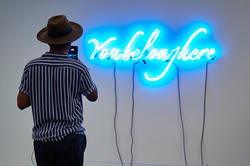Husband-and-wife educators endawnis Spears and Cassius Spears, Jr. kick off the Liberal Arts division’s spring lecture series.
White Hawk Reflects on Resilience

In late November, faculty, staff and students gathered in RISD’s Metcalf Auditorium to hear visiting artist Dyani White Hawk (Sičáŋǧu Lakota) speak as part of the Indigenous and First Nations Artist Series. Hosted by RISD’s Center for Social Equity & Inclusion in partnership with longtime Painting Professor Duane Slick, the series welcomes two visiting Indigenous or First Nations artists each year. Past speakers include artists Nicholas Galanin (Tlingit/Aleut), Sonya Kelliher-Combs (Iñupiaq) and Will Wilson (Diné).
Leading up to the talk, White Hawk spent the week visiting nine different RISD Textiles and Painting studios, where both undergraduate and graduate students were offered one-on-one feedback on work in progress. “I’ve had good visits with students the past couple of days,” says White Hawk. “It’s nice to be able to have a bit of hands-on experience with RISD, an important part of the American art world.”

“I have tremendous gratitude for the artists who came before me and upheld these artistic practices over the generations.”
During her talk, White Hawk referred to resilience, the reclaiming of Indigenous art forms that have been appropriated and how she incorporates traditional Lakota abstraction into her work. “The practices of abstraction in Indigenous art forms and European art forms don’t exist in silos,” she says. “They are completely inseparable. I have tremendous gratitude for the artists who came before me and upheld these artistic practices over the generations.”

White Hawk went on to show a photo of fully quilled moccasins as an example of porcupine quillwork from the Smithsonian National Museum of American Indian Collections. “This Indigenous art form is the precursor to beadwork and a method I heavily incorporate into my work,” she explains.
In the piece Continuity, White Hawk painted in acrylic to mimic quillwork in response to the idea that culture cannot be stagnant. “There are conflicting value systems between academia and other cultural systems,” says White Hawk. “I had to figure out how to incorporate all of the things that are embedded into porcupine quillwork—the context, the teachings, the connection to who I am.”

In response to rampant cultural appropriation in the fashion industry, White Hawk beaded over an appropriated design on a pair of leggings and reinserted Lakota design and symbolism to create Stealing Horses Back. In Resilient Beauty, she painted strips of porcupine quillwork that appear to be peeling off of one side of the canvas and a cotton calico fabric pattern on the other. “The flowers appear to be in motion and lifting off the canvas,” she says. “Everything in the painting is meant to look as though it refuses to be still.”

The theme of resilience echoes through her work, from Quiet Strength, a series of paintings referencing the history of quillwork and beadwork to Takes Care of Them, a series of screen prints the artist made at Highpoint Center for Printmaking in Minneapolis. Both pieces pay tribute to Indigenous women of different generations and the ferocity they embody as nurturers and caretakers.

Perhaps one of the most moving pieces that White Hawk has made about the resilience of Indigenous women is I Am Your Relative, a seven-minute performance piece she staged at the University of Wisconsin–Madison as part of a fundraiser for the Minneapolis-based organization Global Rights for Women. “Before we took the stage, we lele’d [or trilled] really loudly, and the crowd went silent,” says White Hawk. “One by one, different women from the Indigenous community stepped onto the stage and paused for the crowd to read their shirts. It started with ‘I am,’ and then each shirt built from there: ‘I am more than your desire, more than your fantasy. I am ancestral love, prayer and sacrifice.’ The piece ended with ‘I am your relative.’”

In her recent film Listen, White Hawk and cinematographer Razelle Benally (Oglala Lakota/Diné) traveled to various homelands and recorded Indigenous peoples speaking in their native languages. “There are no subtitles,” says White Hawk. “While most Americans can identify 20–25 languages by sound, the vast majority cannot identify a single Indigenous language spoken on the lands where we now live.”
—Isabel Roberts
November 22, 2022


